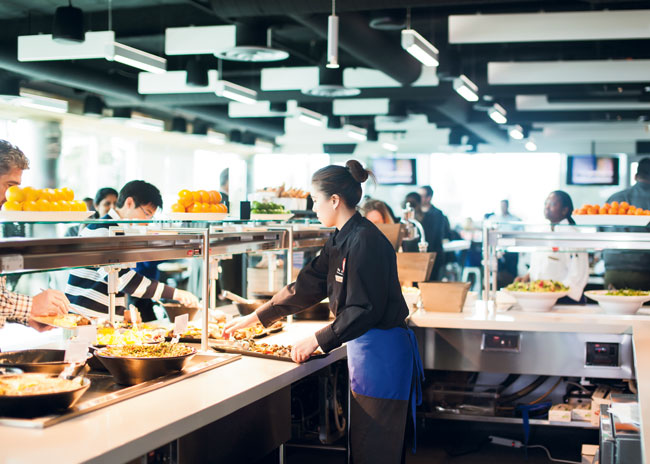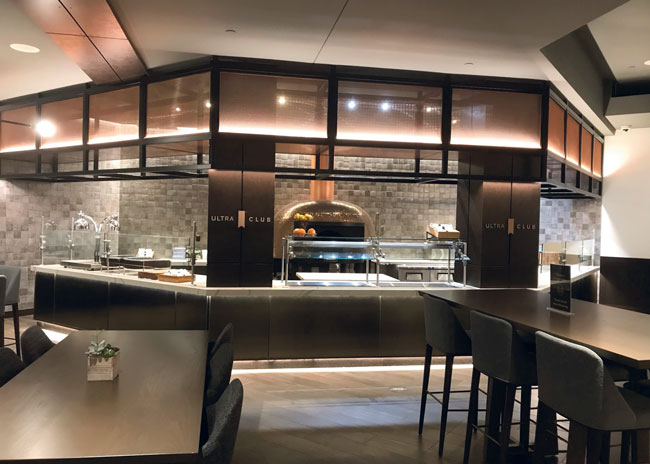Taking a brief hiatus during the pandemic, self-serve hot bars are coming back with design tweaks geared for more hygienic use.
 LinkedIn’s hot bar includes decorative serving vessels for hot food, adding to the overall aesthetic.Though some have taken on a new format, foodservice designers report that staffing shortages and the need for speedy service have kept hot food stations relevant. Today’s hot food bars, for example, often incorporate full-serve components or individually plated or packaged food.
LinkedIn’s hot bar includes decorative serving vessels for hot food, adding to the overall aesthetic.Though some have taken on a new format, foodservice designers report that staffing shortages and the need for speedy service have kept hot food stations relevant. Today’s hot food bars, for example, often incorporate full-serve components or individually plated or packaged food.
“Buffets are still the easiest way to serve a large number of people in a short amount of time,” says Chris Bigelow, president, Bigelow Consulting, Kansas City, Mo. “Even though in some jurisdictions operators have culinary staff serving food from the buffet line, hot equipment is still here.”
For Culinary Advisors, based in Elliott City, Md., self-serve hot bars have been put on the back-burner for projects being worked on in the next year, including quick renovations. “But with new construction that is years out, we are designing [hot bars] like we were before,” says Laura K. Lentz, Culinary Advisors’ design principal. “Right now, it depends on the region as to how these play out, and the picture can look different even in the same segments [depending on the project’s location].”
One of the main alterations has hot bars being downsized to create more space for social distancing. “Hot bars are being placed in open spaces where there can be more circulation, and we’re looking at 6-foot clearances so people aren’t on top of one another,” says Lisa Paige-Pretorius, associate, project manager, Cini•Little, Germantown, Md. “There also are fewer food offerings in these stations.”
Location and Flow
With COVID-19 still top of mind, designers are being even more thoughtful in terms of hot bar location. “We’re isolating or separating hot food stations in the footprint since these areas are less landlocked than made-to-order stations are in a traditional servery,” Lentz explains. “Right now, we are not doing any island self-serve options, but rather putting these stations against perimeters, walls or in locations that can convert from self- to full-serve.”
The latter would include a middle service aisle to accommodate both formats. “In the past, if there was a heated cabinet located in the main kitchen, it wasn’t too much to expect employees would travel farther to replenish the hot bar,” Lentz says. “Two things impacted that. As people want to go through the line faster, throughput has become more critical. Also, we’ve had to get creative due to lack of labor.”
In addition to looking at traffic flow in general, it’s important to understand how food moves from the kitchen to the buffet. In doing so, make sure the operation’s doors and spaces can accommodate the bar’s mobile equipment, Bigelow says. This includes hot or cold storage equipment that may be situated under the buffet line for quick food replenishment. If space is at a premium, operators would be more likely to utilize equipment that’s in the back of the house for this purpose.
“[In this case], hot bars need to be as easy as possible to service from the kitchen without interrupting the dining room flow,” Bigelow says. “As for customer access, people will walk farther to get to the buffet, so these stations should be situated away from main traffic areas.”
Two-sided hot bars are easier to access to refill items, which can prevent traffic flow interruptions. However, this may not always be feasible. “Hot bars in smaller facilities may need to be located up against a wall due to space constraints,” Paige-Pretorius says. “In this case, refilling has to be done on the customer side.”
 This hot bar at LinkedIn’s Mountainview, Calif., offices has convenient kitchen access.
This hot bar at LinkedIn’s Mountainview, Calif., offices has convenient kitchen access.
Adaptability with Versatility
In addition to location, versatility is more important than ever with self-serve hot bars. “Operators want adjustable food shields to be used for either self- or full-service,” says Harry Schildkraut, owner and principal, S2O Consultants, Hawthorn Woods, Ill. “This provides flexibility as things change with the pandemic.”
 This station includes built-in induction warmers, heat lamps for the carving station and adjustable food shields. Adaptability extends to hot- and cold-holding capabilities as these food bars can serve dual purposes. “People are requesting maximum versatility in counters, so with self-serve, they want shelves or wells that can offer both hot and cold items in the same spots to change up the menu and application when needed,” Paige-Pretorius says. “And they want counters with portions that can be shut down for self-serve if the format pivots to full-serve.” She adds that, with the latest technology, heated shelves have become more energy-efficient and there are more quick-switch options to convert hot wells into cold and vice versa.
This station includes built-in induction warmers, heat lamps for the carving station and adjustable food shields. Adaptability extends to hot- and cold-holding capabilities as these food bars can serve dual purposes. “People are requesting maximum versatility in counters, so with self-serve, they want shelves or wells that can offer both hot and cold items in the same spots to change up the menu and application when needed,” Paige-Pretorius says. “And they want counters with portions that can be shut down for self-serve if the format pivots to full-serve.” She adds that, with the latest technology, heated shelves have become more energy-efficient and there are more quick-switch options to convert hot wells into cold and vice versa.
Whether full- or self-serve, appearance remains a top consideration with hot bar design. “The trend is getting away from built-in steam tables and more toward flat heated shelves dropped into or sitting on top of, countertops,” Schildkraut says. “This provides an opportunity to use different kinds of containers like decorative bowls. We’re also seeing operators going toward hidden-mount induction warmers for the same reason. These not only provide flexibility for use with ambient or cold food when turned off but also allow for the use of different display containers that work with induction units.”
Versatility extends to the hot bar setup, and volume takes center stage in this regard. In other words, the number of people being served at one time will dictate how many buffet lines a foodservice operation needs. “You don’t want one 40-foot line when two 20-foot lines will serve more people in a shorter amount of time,” Bigelow says.
The volume also determines how many hot wells or food vessels are needed, the number of utensil dispensers required and the necessary overall elbow space. “With hot bars, we drill into the menu,” Paige-Pretorius says. “Will there be carving stations, soup wells, hot steam wells or hot holding cabinets nearby? Depending on the smallwares package, we may include heated shelves with decorative vessels for a different look and feel. It’s always nice to see cast iron containers as well as different colors being used.”
The visual presentation also should take into account food displays and portion sizes. “Hot food presentation should be in smaller portions, which denotes that items are fresher,” Paige-Pretorius explains. By the same token, signage should note if ladles, spoodles, spoons and tongs have antimicrobial handles, which also signifies cleanliness and added safety measures.
Food guards, though functional, should be considered part of the hot bar’s aesthetic. “These components have become more streamlined and cleaner looking, with more upscale finishes and materials and minimized hardware that emphasizes the food’s appearance and presentation,” Paige-Pretorius says. “The whole aspect of the look and feel of bars will keep being elevated for nice presentations.”
 Notable elements at this pizza station include the pizza oven in back, flat warmers built into the top and adjustable food shields. Fixed food shields sit on each end of the line.
Notable elements at this pizza station include the pizza oven in back, flat warmers built into the top and adjustable food shields. Fixed food shields sit on each end of the line.
Key Equipment
As with the hot bar size, the menu determines what type of and how much equipment is necessary. “We want to see how customers enter the area, first picking up plates and servingware from a dispensing unit,” Bigelow says. “Will they get cold items first and come back for hot food or get it all at once?”
Primary entrees typically sit at the end of the line, and this includes meat at attended carving stations. Smaller hot bars may include hot, cold and ambient foods on a single serving counter. “The big trend now is serving everything on a countertop with smaller vessels holding less food,” Bigelow says. “The downside is this requires replenishment more often.”
This hot bar upscaling has led to more high-end equipment and supplies. “We’re paying closer attention to presentation right now because it says something about our operations inside and out,” Lentz says. “Where before, we may have put in hot and cold wells, now we’re seeing specific requests for hot and cold shelves with forced air, [which has more eye appeal].”
The focus on appearance includes other components not typically associated with hot bars. “We’re seeing more decorative heat lamps to keep items hot,” says Arlene Spiegel, founder and president of Arlene Spiegel & Associates, New York. “These look like they can be light fixtures in a dining room rather than equipment for utilitarian use only.”
Yet, function remains the focus with these stations as designers note more operators seek temperature holding equipment that fits under hot bar counters, such as hot boxes or portable cabinets that can hold backup food. “This way, when items run out, staff doesn’t have to go back to the pantry,” Schildkraut says. “Also, depending on local health department requirements, we’ve been adding undercounter hand sinks. Because customers don’t want to see these on the wall or back counter, we can situate the sink in a slide-out drawer.”
With hot bar designs, it’s imperative to take form, function, appearance and location into account. By ensuring these variables are addressed, the stations will meet the differing needs of customers and attending staff.
 Goodyear’s Akron, Ohio, foodservice facility has pivoted to offer hot bar food items in individual servings.
Goodyear’s Akron, Ohio, foodservice facility has pivoted to offer hot bar food items in individual servings.
Hot Bar Mistakes to Avoid
“Always look at where steam will be released when lids of hot food are opened. You don’t want a TV on the wall to be impacted. Also, consider not only where disposable items like plastic utensils will be dispensed but also provide a convenient receptacle for these to be thrown out.”
Chris Bigelow, president, Bigelow Consulting, Kansas City, Mo.
“Make sure counters are ergonomically constructed so customers can easily reach items in back, and be sure there is proper support equipment for fast and easy replenishing.”
Laura K. Lentz, design principal, Culinary Advisors, Elliott City, Md.
“Take into consideration traffic flow to make sure the hot bar isn’t blocking access to other areas.”
Lisa Paige-Pretorius, associate, project manager, Cini•Little, Germantown, Md.
“Verify that induction warmers are correctly spaced. Frequently, the dish or tray that sits on top of this equipment is not the same size as the warmer, so it will hang out on the sides.”
Harry Schildkraut, owner and principal, S2O Consultants, Hawthorn Woods, Ill.



